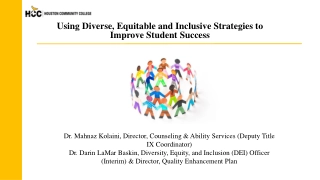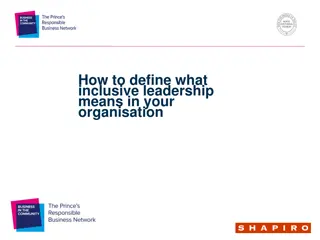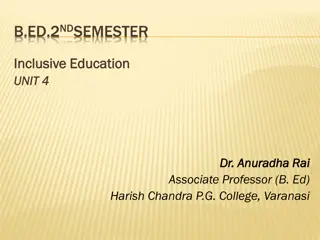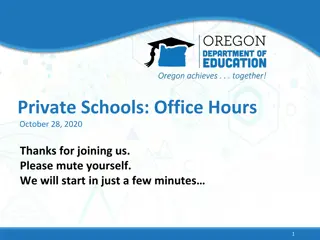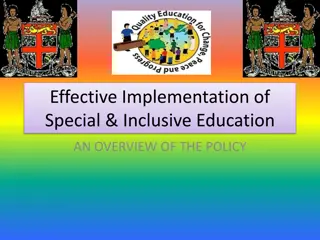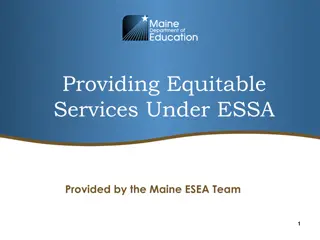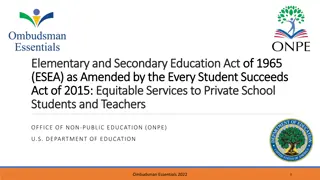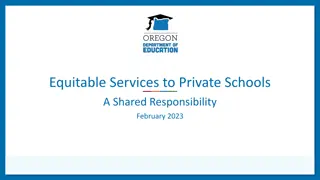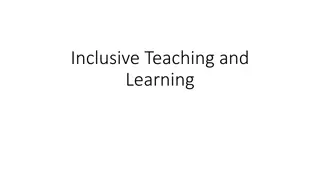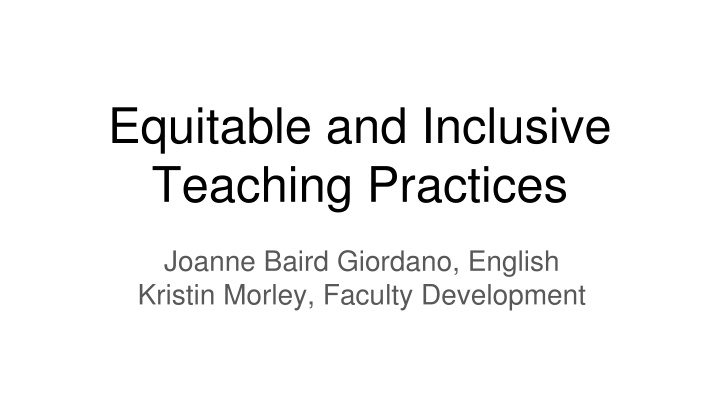
Equitable and Inclusive Teaching Practices Overview
This overview delves into creating equitable and inclusive learning environments, addressing structural inequities, fostering diversity, equity, and inclusion in classrooms, and recognizing barriers faced by students within community college settings. Strategies, principles, and definitions are explored to promote student success and belonging.
Download Presentation

Please find below an Image/Link to download the presentation.
The content on the website is provided AS IS for your information and personal use only. It may not be sold, licensed, or shared on other websites without obtaining consent from the author. If you encounter any issues during the download, it is possible that the publisher has removed the file from their server.
You are allowed to download the files provided on this website for personal or commercial use, subject to the condition that they are used lawfully. All files are the property of their respective owners.
The content on the website is provided AS IS for your information and personal use only. It may not be sold, licensed, or shared on other websites without obtaining consent from the author.
E N D
Presentation Transcript
Equitable and Inclusive Teaching Practices Joanne Baird Giordano, English Kristin Morley, Faculty Development
Session Overview 1. What is equitable and inclusive teaching? 2. Principles for designing an equitable and inclusive course 3. Activity: Simple strategies for reducing barriers to student learning 4. Quick overview of Equitable and Inclusive Teaching Practices Credentialing
Diversity, Equity, and Inclusion in a Class Diversity: People with different social and cultural identities are present; the course content and curriculum represent diverse perspectives. Equity: All students have equitable access to opportunities, fair treatment, resources for success, and fair processes. Inclusion: The instructor and institution have created conditions in which all students can learn and succeed; all students are valued, feel safe, and have a sense of belonging within a community of other learners.
What Is Equitable Teaching? Creating conditions that provide all students with equal opportunities for learning Recognizing and directly addressing structural inequities that interfere with learning and educational achievement Using fair and transparent processes for teaching and assessing learning
What Is Inclusive Teaching? Using teaching strategies that help all students do their best learning Creating conditions for success Responding to students unique needs Valuing students diverse perspectives and experiences Respecting students cultural and social identities Creating a sense of belonging
A course or a classroom can have diversity but also be inequitable.
Structural Inequities for Community College Students No internet access at home Shared family study space or a computer No control over work hours Food insecurity Lack of access to mental health services Caregiver responsibilities Unsafe living conditions because of housing discrimination Inadequate transportation Barriers to learning and educational access that come from students social and cultural backgrounds, circumstances, or identities Rooted in inequities in society- -not students choices
Equitable and Inclusive Teaching Practices Course Facilitated online faculty development 8 weeks + orientation and resources modules Practical teaching strategies Asynchronous interaction with other instructors Adjunct compensation Open to anyone who teaches (or designs instructional materials)
Equitable Teaching Starts with Course Design Planned Purposeful Reflective (self-assessing) Transparent Student-centered Learning-focused Process-based Disciplinary
A Framework for Course Redesign 1. Reorient your thinking 2. Assess what s working 3. Restructure the learning environment 4. Redesign the course 5. Reflect on changes 6. Adjust your strategies
Examples of Course Redesign Activities Assess the course and identify barriers to student learning Set equity-focused teaching goals Redesign the structure of a course to support educational achievement Develop student learning goals (or review program-level outcomes) Plan an inclusive learning environment Create an equitable assessment plan Design equitable, transparent, and varied ways to assess learning Plan for scaffolded classroom and/or online support Design activities to help students achieve learning goals Assess and revise the syllabus and course policies
Create an Action Plan Develop a practical, organized plan for teaching an equitable and inclusive course To do list Schedule Spreadsheet
Strategy 1: Assess Barriers to Student Learning 1. Design a low stakes activity to assess students learning early in the semester 2. Identify barriers to student success for the assigned activity 3. Develop one new teaching strategy to support student success Examples of Low Stakes Assessments A reflection on course learning or prior experiences A non-graded quiz on key concepts from readings A short in-class writing activity A group quiz to identify unclear concepts
Identify one activity that you might use in the first month of the semester to assess barriers to student learning.
Strategy 2: Add an Assessment Method 1. Select an existing course assignment, test, or other activity for assessing student learning 2. Revise the assignment to reduce barriers to student learning 3. Identify one additional method for helping students demonstrate their learning 4. Develop a new assessment activity and assign it as a new option
Examples of Multiple Methods for Assessing Learning Research paper Reflective essay Web page or supplemental ePortfolio page Video Narrated slideshow Oral presentation Discussion leader assignment Create a study guide Develop a handout Podcast Focus on the outcomes or learning goals of the assessment activity
Select a graded activity for one of your courses. Identify an alternate activity that students might do to demonstrate their learning.
Strategy 3: Change One Policy 1. Review your course syllabus. 2. Identify policies or approaches to teaching that might potentially create barriers to learning for students in an open-access teaching environment. 3. Make one change to your syllabus that focuses on creating equal access to learning for all students.
Examples of Course Policy Changes Revise the wording of a policy to make it more transparent and clear Develop an inclusive course communication policy Revise a late work policy to accommodate students who work full-time, have a mental illness, have a disability, or have a personal emergency Create opportunities for students to make up missed in-class work Add student choice to assignment completion requirements Revise policy language to make the course learning environment more supportive and encouraging (and less scary) Adjust office hours to accommodate online students who work full-time
Give an example of a course policy or teaching practice that creates equal access to learning for all students.
Equitable and Inclusive Teaching Practices Credentialing Level 1: Design an Equitable and Inclusive Course Take the EITP online course; redesign a course (1 semester or summer term) Level 2: Teach an Equitable and Inclusive Course Teach the course; reflect on and discuss teaching; complete an equity-minded faculty development activity (1 semester or summer term) Level 3: Engage in Equity-Minded Teacher-Scholar Work Design and complete a teaching-focused equity project; receive mentoring (self-paced)
Equitable and Inclusive Teaching Practices Course Spring 2021 Cohort For More Information February 1: Registration available Joanne Giordano, English (joanne.giordano@slcc.edu) Kristin Morley, Faculty Development (kristin.morley@slcc.edu) Nancy Barrickman, Biology (nancy.barrickman@slcc.edu) February 8: Module 1 starts February 12: Registration closes Register through your employee training portal in My SLCC

